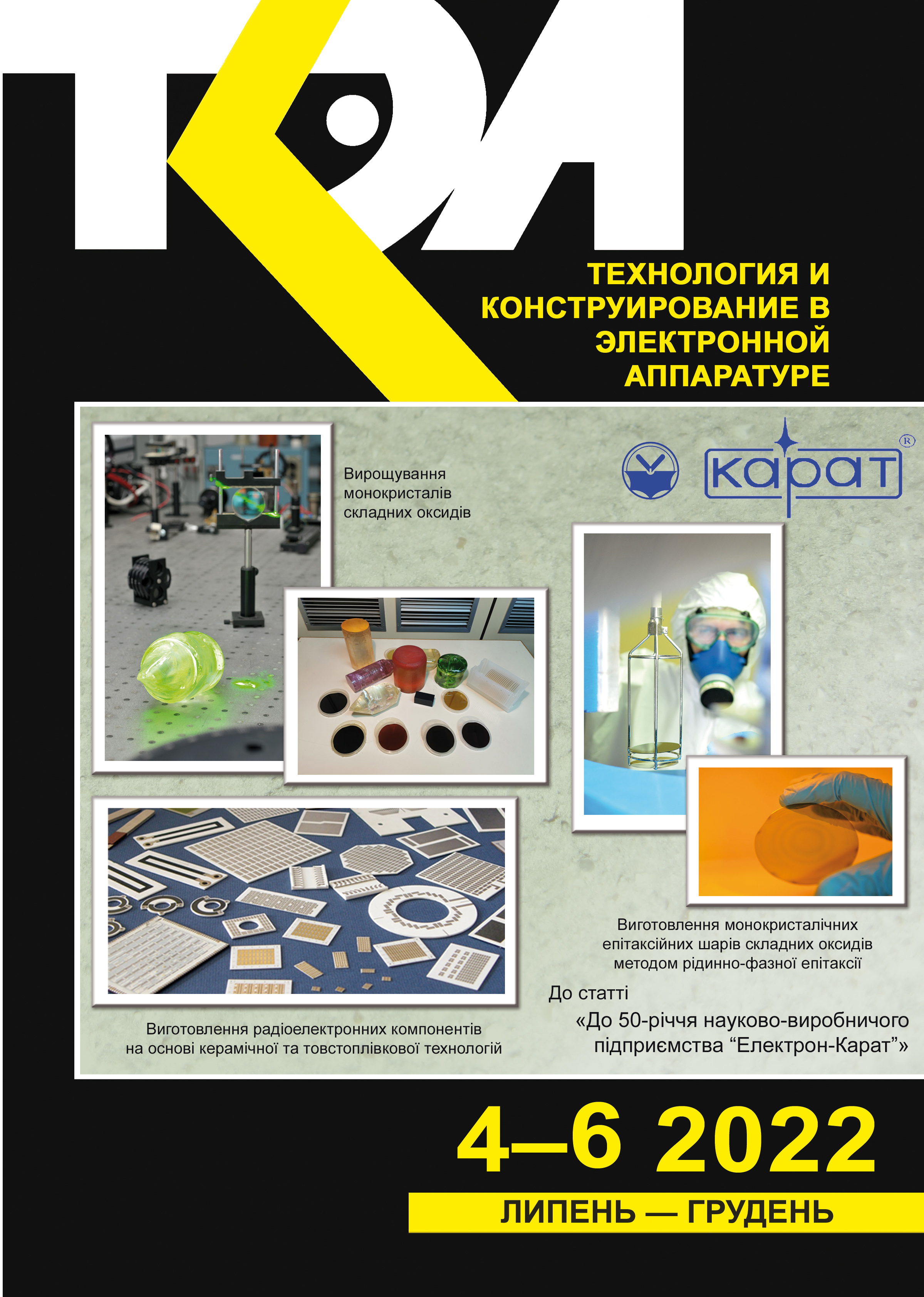Resistive humidity sensors based on nanocellulose films for biodegradable electronics
Abstract
Nanocellulose (NC) is a promising modern material suitable for use in electronics. This material is biodegradable, and thus, if used in electronic devices, will not require disposal and will decompose naturally. An interesting feature of nanocellulose is its hygroscopicity, which makes it applicable for the manufacture of humidity sensors. In this study, we synthesized nanocellulose-based humidity sensors with a weight of humidity-sensitive layer from 0.3 to 3.6 mg. The following static and dynamic characteristics of the obtained sensors were measured: sensitivity, response, hysteresis, repeatability, response and recovery time, short and long-term stability. It was determined that at a frequency of 100 Hz, the maximum sensitivity was observed in the sample with NC mass of 1.8 mg (0.215 (%RH)-1), and at 1000 Hz, in the sample with NC mass of 0.5 mg (0.155 (%RH)-1). Thus, with increasing frequency of test signal, the sensitivity of the sensors decreases. These same samples (with NC mass of 1.8 mg at 100 Hz and 0.5 mg at 1000 Hz) showed the highest values of sensor response — 1.99·106 and 5.43·104, respectively. Same as with sensitivity, when frequency increases, sensor response decreases. For both frequencies, the sample with NC mass of 0.4 mg showed the lowest value of hysteresis - 0.04 and 0.12% at 100 and 1000 Hz, respectively. It was also found that the sample with NC mass of 0.3 mg has the shortest response time of 42 s. With increasing of NC weight, the response time increases about 20-fold and recovery time - by 2 orders of magnitude. The highest short-term stability was demonstrated by the sample with NC weight of 0.5 mg: deviations from the arithmetic mean were 8 and 7.8% at test frequencies of 100 and 1000 Hz, respectively. The worst short-term stability was demonstrated by the sample with NC mass of 3.3 mg with the deviation of 31.7 and 39.2% at the same frequencies. It was also determined that such sensors need to be further researched to improve long-term stability.
Therefore, the measurement results demonstrate that, in terms of sensitivity and response, the optimal mass of NC film is 1.8 mg at the test frequency of 100 Hz. This sample also shows the best long-term stability. From the point of view of recoverability and sensor speed, the sample with NC weight of 0.3-0.5 mg is preferable.
References
Jung Y. H., Chang T.-H., Zhang H. et al. High-performance green flexible electronics based on biodegradable cellulose nanofibril paper. 2015, Nature Communications, vol. 6, iss. 1, аrticle 7170, https://doi.org/10.1038/ncomms8170
Lapshuda V. A., Koval V. M. Flexible and biodegradable sensors: materials, manufacturing technology and devices on its basis. KPI Science News, 2021, no. 2, pp. 16–27, https://doi.org/10.20535/kpisn.2021.2.229964
Koga H., Nogi M. Cellulose paper composites for flexible electronics. Chapter 6 in the book "Lignocellulosics", Elsevier, 2020, рр. 171–179, https://doi.org/10.1016/B978-0-12-804077-5.00011-7
Kafy A., Akther A., Shishir Md. I. R. еt al. Cellulose nanocrystal/graphene oxide composite film as humidity sensor. Sensors and Actuators A: Physical, 2016, vol. 247, рр. 221–226, https://doi.org/10.1016/j.sna.2016.05.045
Agate S., Joyce M., Lucia L., Pal L. Cellulose and nanocellulose-based flexible-hybrid printed electronics and conductive composites — A review. Carbohydrate Polymers, 2018, vol. 198, рр. 249–260. https://doi.org/10.1016/j.carbpol.2018.06.045
Hoeng F., Denneulin A., Bras J. Use of nanocellulose in printed electronics: a review. Nanoscale, 2016, vol. 8, iss. 27, рр. 13131– 13154, https://doi.org/10.1039/C6NR03054H
Barbash V. A., Yaschenko O. V., Shniruk O. M. Preparation and properties of nanocellulose from organosolv straw pulрр. Nanoscale Research Letters, 2017, vol. 12, iss. 1, аrticle 241, https://doi.org/ 10.1186/s11671-017-2001-4
Koval V., Barbash V., Dusheyko M. et al. Application of nanocellulose in humidity sensors for biodegradable electronics. 2020 IEEE 10th International Conference Nanomaterials: Applications & Properties (NAP), pp. 02NS01-1-02NS01-5, https://doi.org/10.1109/NAP51477.2020.9309598
Barbash V. A., Yashchenko O. V., Gondovska A. S., Deykun I. M. Preparation and characterization of nanocellulose obtained by TEMPO-mediated oxidation of organosolv pulp from reed stalks. Applied Nanoscience, 2022, vol. 12, iss. 4, pp. 835–848, https://doi.org/10.1007/s13204-021-01749-z
Syrovy T., Maronova S., Kubersky Р. et al. Wide range humidity sensors printed on biocomposite films of cellulose nanofibril and poly(ethylene glycol). Journal of Applied Polymer Science, 2019, vol. 136, iss. 36, аrticle 47920, https://doi.org/10.1002/app.47920
Zhu P., Kuang Yu., Wei Y. et al. Electrostatic self-assembly enabled flexible paper-based humidity sensor with high sensitivity and superior durability. Chemical Engineering Journal, 2021, vol. 404, аrticle 127105, https://doi.org/10.1016/j.cej.2020.127105
Zhu B., Johansen V., Kamita G. et al. Hyperspectral imaging of photonic cellulose nanocrystal films: structure of local defects and implications for self-assembly pathways. ACS Nano, 2020, vol. 14, iss. 11, рр. 15361–15373, https://doi.org/10.1021/acsnano.0c05785
Yoshida A., Wanga Y.-F., Tachibana Sh. et al. Printed, all-carbon-based flexible humidity sensor using a cellulose nanofiber/graphene nanoplatelet composite. Carbon Trends, 2022, vol. 7, аrticle 100166, https://doi.org/10.1016/j.cartre.2022.100166
Zhu P., Liu Yu, Fang Zh. et al. Flexible and highly sensitive humidity sensor based on cellulose nanofibers and carbon nanotube composite film. Langmuir, 2019, vol. 35, iss. 14, рр. 4834–4842, https://doi.org/10.1021/acs.langmuir.8b04259
Xu S., Yu W., Yao X. et al. Nanocellulose-assisted dispersion of graphene to fabricate poly(vinyl alcohol)/graphene nanocomposite for humidity sensing. Composites Science and Technology, 2016, vol. 131, рр. 67, https://doi.org/10.1016/j.compscitech.2016.05.014
Khalifa M., Wuzella G., Lammer H., Mahendran A. R. Smart paper from graphene coated cellulose for high-performance humidity and piezoresistive force sensor. Synthetic Metals, 2020, vol. 266, рр. 116420, https://doi.org/10.1016/j.synthmet.2020.116420.
Barbash V., Yaschenko O. Preparation, properties and use of nanocellulose from non-wood plant materials. Chapter 4 in the book "Novel Nanomaterials", IntechOpen, 2020, 23 р., https://doi.org/10.5772/intechopen.94272.
Copyright (c) 2022 Vladyslav Lapshuda, Yaroslav Linevych, Mykhailo Dusheiko, Viktoriia Koval, Valerii Barbash

This work is licensed under a Creative Commons Attribution 4.0 International License.

